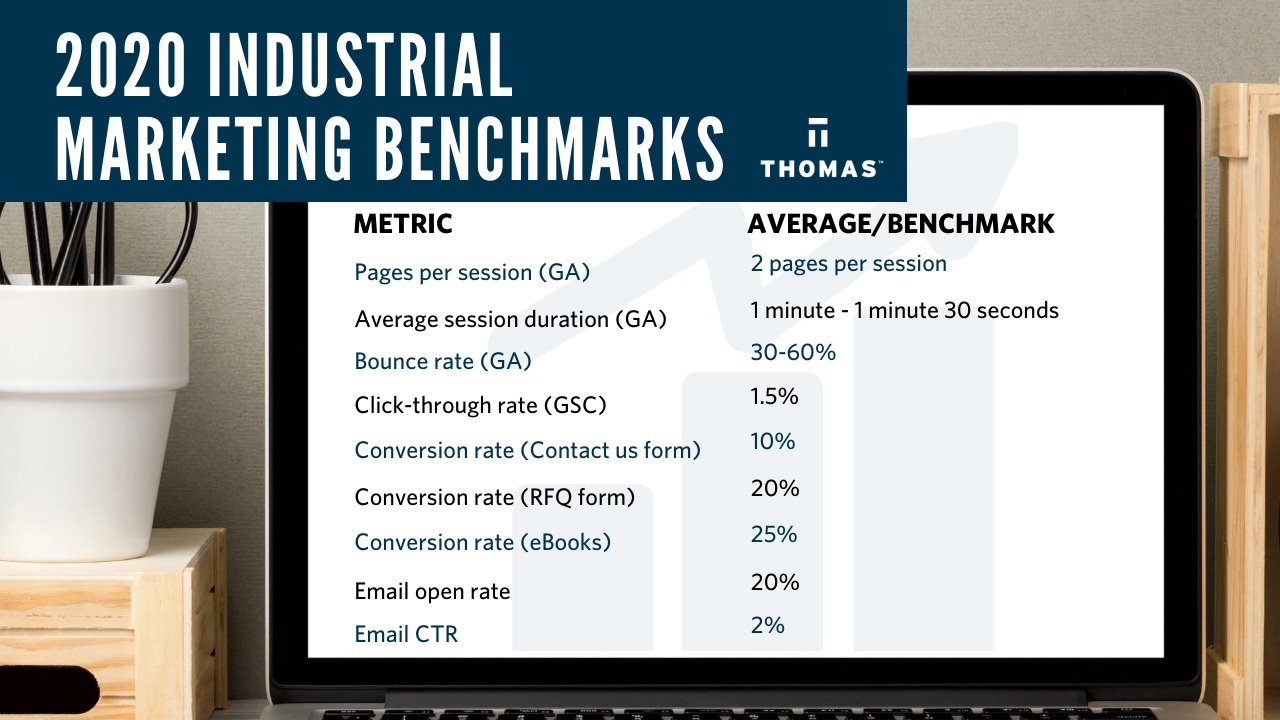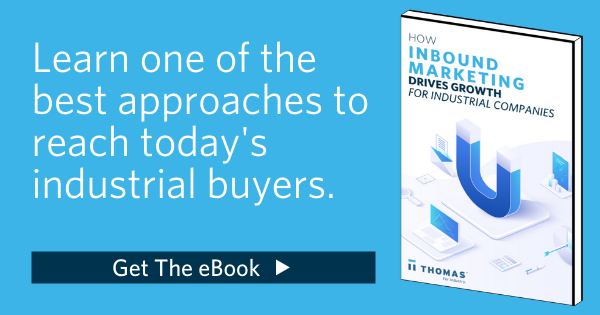Inbound Marketing ROI: For Industrial Companies & Manufacturers
Team Thomas December 2, 2020
As the digital world continues to shape the industrial world, marketing budgets shift from trade shows to online efforts. According to Engineering.com's annual survey of engineering marketers, twice as many respondents reported that their budgets were growing rather than shrinking in 2017. The latest Thomas Industrial Survey assessing the ongoing impacts of COVID-19 on North American manufacturing revealed that 21% of companies are less likely to invest in trade shows while the use of webinars & virtual events (20%), search & social media (14%), and website (12%) all increased in light of COVID-19.
Like with any investment, marketers and manufacturing companies want to ensure that they receive a positive return. We’ve outlined the effectiveness of inbound marketing in tracking ROI and why it's important for manufacturers and industrial companies today.
How Does Inbound Marketing Work?
The main idea behind inbound marketing is that you're creating content and web pages that draw people to you, rather than you going after them. Unlike traditional advertising methods involving "interruptions" and contacting anyone you think could benefit from your products, you're tailoring your marketing to interested buyers who are seeking resources to get their jobs done. When you present insights that align with their goals, they are more likely to buy from you.
Think back to the last time you had a pressing issue either at home or at work, and needed an answer quickly. If the first place you turned was Google, you’re probably like most people in a similar situation. That's the goal of your online content — to draw more of the right people in and solving their issues with your resources.
The result is a more meaningful relationship with prospects and customers to grow your business. Your sales, support, and marketing teams, in turn, receive more qualified leads rather than spending time vetting through cold leads.
Good content in the form of blogs, eBooks, email campaigns, webinars, infographics, videos, etc. is the core of any successful inbound marketing program. When the content is high-quality and unique, customers find success, and they are more likely to share your resources with others, creating a loop of more opportunities and new business for you.
Inbound Marketing Has A Lower Cost Per Acquisition
Yes, implementing an inbound marketing strategy requires an initial monetary investment, but in the long run, it actually costs less money to run an inbound program than it does to run a traditional marketing program.
Businesses that rely on inbound marketing strategies save more than $14 for every newly acquired customer, which adds up to significant savings over time.
Plus, inbound leads cost an average of 60% less than outbound leads. With the average cost per lead dropping 80% over five months of consistent implementation of inbound campaigns, savings accumulate quickly, allowing companies to put those resources toward other areas needing enhancement or improvement.
Unlike traditional marketing (trade shows and phone calls), inbound marketing works a little differently to attract leads — it leverages useful customer-focused content that encourages prospects to build a relationship with your company. Trade shows are more difficult to quantify — how can you justify the cost of how many people visited your booth? Inbound marketing efforts are measurable and much more efficient for your sales cycle and your bottom line:
- Your content appeals to customers at all stages of the buying cycle.
- Your content is generally hosted on your site and gets you found by buyers with no costs for clicks or impressions.
- Your content creates a relationship and brand loyalty, which naturally fosters repeat business.
Effective brand marketing with inbound efforts make it easier to build trust and establish a human connection — an element buyers are seeking more today.
💡 Case Study: E2Global’s new inbound marketing efforts, content marketing, and lead generation campaigns helped them achieve 4x the revenue growth than their outbound sales efforts ever did. Learn how E2Global, a provider of turnkey consumable manufacturing services, keeps track of ROI.
More Qualified Website Visitors Contribute To ROI
Inbound marketing centers on providing directly useful, engaging content to prospective clients to catch their attention and make them more aware of your company; ultimately, of course, the goal is to move them from one stage of the sales funnel to the next — converting them from a website visitor to a lead, and from a lead to a paying customer.
It inverts the model of advertising that attempts to reach buyers when they’re engaged in other activities, and seeks to be more relevant to their needs and bring them to you (more on that funnel in our eBook How Inbound Provides Growth For Manufacturers).
According to a report conducted by an MIT Sloan MBA student analyzing HubSpot data, inbound marketing is, in fact, extremely effective in securing valuable leads and getting them to convert. The report found that using inbound marketing software resulted in 3.3 times more site visitors per month within one year, and during this same time period, it resulted in 3.5 times more leads. Overall, 79% of inbound customers saw an increase in sales revenue within a year.
Overall, 79% of inbound customers saw an increase in sales revenue within a year.
How To Increase Your Inbound Marketing ROI
1. Identify And Set Your Goals Up Front
“Return on investment” (ROI) means nothing without targeted goals and benchmarks. The very first step to capturing ROI is assessing your current marketing plan and determining what you’d like to improve. Email marketing, for instance, can show you how many people opened your email, what they clicked in it, and whether or not they pursued more information from you. Social media tracking can show you what time of day is best to post, depending on past performance. But to determine marketing ROI, you need to keep track of Key Performance Indicators (KPIs), which means the markers on your roadmap to more business. KPIs are typically “big-picture” measurements. Focus on conversion rates, traffic to your website, leads generated or customers converted from leads.
Depending on your goals, KPIs can also be more specific. For instance, you can measure the rate of upselling existing customers, the increase of e-commerce orders, or number of lead conversions from emails or blogs. Marketing apps and tools like HubSpot and Google Analytics will help you track your website efforts and identify benchmarks of success.
If you're a distributor, product data alignment between you, your vendor, your website and theirs, makes your company easy to do business with and keeps them on your website longer — but what makes it easier to manage your opportunities is if you have an effective online product catalog built for you and your partners too. Ensuring you have the right measurements in place on the back-end will not only signal you if something is wrong, but will help you spark new ideas to stay in front of customers.
Learn More: How To Improve Your Supplier-Distributor Relationship
2. Determine Your Ideal Buyer
The next step to beginning an inbound marketing campaign is determining the ideal buyer you want to reach. This is called identifying your personas and involves figuring out who your perfect prospect would be, and tailoring your content marketing to that person. It is not based on any one person in real life, but is instead a conglomeration of your overall audience. Therefore, you should consider a few key traits (industry, job function, age, challenges, etc.) and build a persona based on these qualities.
Read More: The Three Most Influential Buyers In The Industrial Buying Process
Thomas WebTrax is a lead generation tool that turns your anonymous web traffic into sales leads for your manufacturing — it lets you see exactly who is engaging with your content online. Collecting data on the right users will allow you to get inside your customers’ heads and identify their problems and frustrations. These insights help you tailor your messaging and overall marketing efforts to meet your customers' needs better and get more out of your budget.

"WebTrax lets us see what our target customers and target industries are looking at on our website so we can be prepared to answer their questions on those issues and even order advanced inventory," said Julia Mace, Marketing Leader at SUS America, Inc.
See Who's Searching For Your Industrial Products And Services Today With A Custom Prospect Report
3. Identify Topics That Appeal to Your Target Audience's Problems
Instead of looking for answers to a problem, inbound marketing is figuring out other people’s problems and providing the answers they’re looking for. Once you have identified the type of person you’re trying to reach and what challenges they face at work, determine how your services can help them. Brainstorm content that responds to those challenges — see 10 content marketing ideas here.
With the proliferation of the internet, today’s consumers are more informed than ever. Buyers will actively review each company that can meet their needs and see who is the best option based on numerous factors (aka making it on the shortlist). It’s not so much about price or availability of services anymore, it’s also about your reputation and how your online presence ties it all together. Many companies can provide the same products as you, so you need to make sure your web presence is on par, if not surpassing your competition.
After identifying common questions and concerns among your buyer personas, think of a few ways to answer them. Often, you’ll have several options to consider — and it's important to be everywhere your buyers are. If your audience is active on social media, you may want to create something visually compelling that will get shared. Infographics and videos are great ways to gain exposure. In addition to your own delivery methods (publishing a blog, email newsletter, social media postings, etc.), visual content is very shareable. Therefore, the direct recipients of your message will be likely to share this information with their audiences, and so on. You’ll still want to attract visitors back to your site so you can track leads and conversion, so make sure that any content you’re creating has a place to live on your website.
Inbound marketing efforts create resources for you to reuse and repurpose for new audiences. But your content needs to be clear and unique — ask yourself, "How will this benefit people?" Remember that people will overlook very long or confusing titles, so keep it basic, yet compelling.
Learn More: How To Use Content Marketing To Generate Leads
For longer pieces of content like blogs or eBooks, remember that you’re writing both for people and search engines. Think of relevant keyword phrases that people might search for online and incorporate those terms throughout your piece. But, do so in a way that is natural and easy to read. You want people to find you in a Google search, but you don’t want to lose them because your content is painful to read.
Here are a few examples of what engineers, procurement managers, and MROs are looking for:
- A Beginner's Guide To Enhanced Ballistic Materials
- What Is Flexible Packaging?
- Today's Best Practices For Metal Stamping Design

5. Nurture Your Leads Through the Sales Funnel
Attracting your audience is important, but it’s not your final objective. Your manager is looking for ROI through sales, and as much as you understand the value of retweets and shares, you also know that the purpose of marketing is to provide more leads for your sales team. This is where the all-encompassing aspects of inbound marketing come together.
With inbound marketing, attracting customers to your site is only the first step in the sales process. Unlike outbound marketing, where you’re only addressing a narrow cross-section of buyers ready to make a purchase — inbound marketing appeals to a broader audience, while still targeting the B2B buyers, engineers, and procurement managers you want to do business with.
Once buyers find you through inbound marketing and they're engaged with what they see, they’ll likely want more of your voice, more of your content, and more of your brand. There are a few ways that you can provide this — and make sure that they’ll think of you when they do reach that ready-to-buy stage:
- Email nurturing
- Regular content updates
- Cross-platform promotion
Once you create an eBook, white paper, or other piece of valuable content, create a complementary form, landing page, and awesome CTAs to go with them — they're the must-have mechanics to successful industrial lead generation. After prospects enter their information in exchange for the content, they’ll be considered leads, rather than just strangers. There are four main steps in the inbound marketing methodology: Attract, Convert, Close, and Delight. Your content aims to attract visitors, who are “converted” to leads once they fill out a form.
From there, you'll be able to move them through the sales funnel more easily — this is because when you have their information, you can begin a lead nurturing campaign, and deliver content based on their interests. They will be super informed before the sale call happens, which makes a better conversation.
But the inbound marketing process isn’t over yet!
The last step of the inbound marketing methodology is to delight new customers by continuing to provide them with the information and services they’re looking for. The main idea is to foster a strong relationship that will turn these customers into promoters of your brand and share your content within their own channels to help sell your services for you. Remember, the main goal of inbound marketing is not to sell your services, but to pass along your knowledge. If you do this successfully, your delighted audience will do the rest for you.
Learn More: How Inbound Marketing Ties Into The Stages Of The Buying Process
6. Evaluate Your KPIs And Metrics
Based on your KPIs, the measuring step is the most important in quantifying your inbound marketing program results. However, your KPIs are just the first step in determining your actual ROI.
You may want to include a number of other factors to make your ROI calculation, including:
- Cost of overall marketing program
- Cost per lead
- Cost per sale
- Overall length of customer relationship (are you getting repeat business?)
You’ll also have specific metrics for each campaign — ones that you can analyze to improve your numbers.
Based on research and lead generation online marketing campaigns with manufacturers and industrial companies, Thomas' established some of the following B2B benchmarks for 2020:
- The average pages per session are two pages
- The average session duration is 1 minute to 1 minute 30 seconds
- The average bounce rate is between 30- 60%
- The average click-through rate to a website page is at 1.5%
- The average conversion rate using a contact us form is 10%
- The average conversion rate using an RFQ form is 20%
- The average conversion rate for an eBook download is 25%
How are your benchmarks faring against the industry? Request a free digital health check to see how you can improve.
7. Report Your Findings Regularly To Track ROI
As with anything new, it can be difficult to get other decision-makers on board to invest. The best way to prove the benefits of inbound marketing? The bottom line.
A solid inbound marketing plan will ideally affect both sides of the ROI equation — not only will you see leads coming in more consistently, and converting more often to sales, but you’ll also see your overall acquisition costs decreasing.
A study from Forrester found that 43% of CEOs believed that misalignment had cost them sales. Digital tracking and reporting tools, like HubSpot will enable you to report on tangible, goal-focused improvements in your marketing program. Your teams will be more aligned from the increased visibility of your campaigns because there’s no better way to answer questions and alleviate concerns than with hard facts. Inbound marketing arms you with those facts, real results, and real business.
Learn More: How To Pitch Digital Marketing To Your Manager
Use Inbound Marketing To Grow Your Manufacturing Business Better
If you don't yet see the ROI you're expecting, work back through each step:
- Set new goals — perhaps more short-term improvements, or adjusted expectations.
- Continue to create quality content — the best content lives on your website or other outlets to ensure that you keep getting found online
- Engage with your prospects regularly — remember that inbound attracts buyers at all stages of the purchasing cycle, so they just may not be ready to place an order yet.
- Review your metrics and measurements — study what worked, what didn’t, and adjust your methods accordingly.
A key thing about Thomas is the ability to generate a lot of leads across various industries. We wanted to help educate our customers. Through eBooks, blogs, a revamped website — they actually drive our own knowledge out and customers appreciate the insight.
To learn more about the great ROI offered by inbound marketing, download our guide How Inbound Marketing Drives Growth For Industrial Companies — or contact us if you need help to put your plan in action. We can tailor an inbound program with targeted content marketing specifically suited to your company’s needs and marketing goals.
Did you find this useful?








![How To Meet The Needs Of B2B & Industrial Buyers [Updated 2022]](https://blog.thomasnet.com/hubfs/Brainstorm%20meeting%20understanding%20B2B%20buyers.png)


